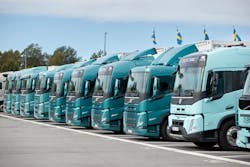Volvo leaning on global EV experience to help fleets electrify
With more electric trucks entering production, one of the biggest things holding back short-haul fleets from utilizing this zero-emission technology is the long lead times and extensive planning required to set up charging infrastructure.
Volvo Trucks was the first global trucking OEM to begin serial production of its heavy-duty battery-electric trucks. More than 6,000 electric Volvo trucks operate in more than 40 countries today. That is about half of all the heavy-duty electric vehicles worldwide.
The truck maker is using what it has learned in earlier European rollouts to help customers set up charging infrastructure on the other side of the Atlantic.
“There is not only one silver bullet solution that will make it happen,” Volvo Trucks President Roger Alm told North American journalists at Volvo Trucks headquarters in Gothenburg, Sweden, in September. “I think that we need to bring the whole value chain—with the politicians, with the manufacturers, with oil companies or energy companies—into this transformation as well. But one of the key elements is, of course, charging infrastructure.”
See also: Volvo sees BEV as the main path to cutting carbon from U.S. trucking
It could take some U.S. fleets more than a decade to build out charging infrastructure, according to a recent study by the North American Council for Freight Efficiency. Volvo Trucks North America, which has been working with early EV-adopting carriers since 2019, wants to take on the infrastructure headaches for fleets. The OEM launched its Turnkey Solutions electromobility program this summer.
“For customers who decide to have everything handled from a charging infrastructure perspective, Turnkey Solutions is the easy option to go,” Subbu Arumugam, VTNA’s senior project manager for electric vehicles, told FleetOwner. “The process starts with the dealer setting up a meeting with our customer and the Turnkey Solutions provider, who are well versed to understand the short- and long-term needs of the customer, their operational needs, and recommend the right solution for them.”
Arumugam said Volvo Truck customers can contact their dealers or sales representatives to set up an initial review of the electrification options. He said that the company is already strategizing with some fleets.
“The Turnkey Solutions program is recommended for customers who want a hands-off approach to charging and infrastructure solutions,” Arumugam explained. “It can be scaled for different fleet sizes and support the needs of our customers where they operate. The lead times will vary based on the customers’ current infrastructure, city permit process, utility timelines, to name a few.”
For fleets that don’t want to wait on long charging infrastructure projects before deploying the Volvo VNR Electric, a Class 8 EV for regional haul, Arumugam said the Turnkey Solutions providers can recommend off-grid charging solutions for both short- and long-term needs.
How should fleets start the electrification journey?
The chicken-or-the-egg conundrum for some fleets is where to start: Do you buy electric trucks or set up charging infrastructure first?
"Regional hauls are a great segment to plan for electrification,” Arumugam suggested. “It’s never too early to start. There are different factors that come into play when deciding which to procure first. For example, for a site that doesn’t have the capacity that is needed, the infrastructure is the first place to start.”
He added that EV-certified Volvo dealers can guide fleet managers through the first steps. As of May, VTNA has 36 dealers in 19 states certified to sell and service electric trucks. The OEM has more than 50 other dealers working toward certification.
See also: Trucking businesses, climate activists must work together
Jessica Sandström, Volvo Trucks head of product management, said that Volvo has already learned much about helping fleets deploy charging infrastructure to support EV operations. “I think we’ve learned a lot about how we need to collaborate with both the players who build the infrastructure—but also with our competitors,” she said. “Because it doesn’t really make sense if we all have different views.”
She added that because of Volvo’s experience with alternative energy, it has experience with all sorts of energy stakeholders—from governments to utilities to customers. “But I believe that what makes the difference is when you see that it really works,” Sandström said during the media briefing in Gothenburg. “That is why we are so proud that we have now sold the 6,000 trucks. Because those are credible ambassadors. Many of those drivers were skeptical in the beginning. But now that they see it really works, no one wants to go back.”
What questions should fleets ask about electrification?
Getting started on electrifying a fleet of any size can be daunting. Charging infrastructure includes chargers and interrelated systems of vehicles, duty cycles, chargers, and electric utilities, according to NAFCE’s Charging Forward with Electric Trucks report, published this summer.
“While there are a great many factors that impact the scaling of electric vehicles for hauling freight, careful planning and collaboration will help make the process go more smoothly,” according to Mike Roeth, NACFE’s executive director. “The guidance in this report should give fleets confidence to move forward with adding more electric vehicles to their operations."
With local and federal regulators pushing the industry to decarbonize, even if your fleet isn’t planning electrification this decade, it’s not too early to start thinking about it.
See also: Truck charging in the 'real world'
VTNA’s Arumugam suggested that fleet managers start thinking about future goals, not just short-term plans. “This will help your provider to plan this better for you,” he said. “Ask them if they are coordinating the delivery of vehicles and the charging system together. Ask about their contingency plans. Ask about all the incentives that they can leverage. Check if distributed energy systems (DERs) could work at their location and if it could provide value for them in the long run.
“Make sure your requirements are clear,” he continued. “If you are planning electrical or civil upgrades to your facilities in the near term, make the providers aware so that it can be planned effectively.”
Volvo’s fleet electrification growth
Volvo Group, including VTNA, is working to achieve 35% zero-emission vehicle sales by 2030 and become net-zero by 2040. The Volvo Trucks Certified EV Dealership program was designed to increase VNR Electric sales and develop a service ecosystem to support fleet customers deploying the Class 8 battery-electric trucks.
The robust sales goal appears to be working. VTNA President Peter Voorhoeve credited VNR Electric’s sales growth over the past year to the early success of the Volvo LIGHTS project, which ran from 2019 to 2022. The OEM created a public-private partnership to design and implement a blueprint to support an electric fleet ecosystem at scale.
“In the beginning, you needed to sell the story to your dealers,” Voorhoeve told FleetOwner during an interview at the Advanced Clean Transportation Expo in May. “Because we were very successful with selling the Phase One truck, they were like, ‘alright.’ I think it was a compelling story that they saw—because we didn’t have to push that much.”
About the Author
Josh Fisher
Editor-in-Chief
Editor-in-Chief Josh Fisher has been with FleetOwner since 2017. He covers everything from modern fleet management to operational efficiency, artificial intelligence, autonomous trucking, alternative fuels and powertrains, regulations, and emerging transportation technology. Based in Maryland, he writes the Lane Shift Ahead column about the changing North American transportation landscape.





